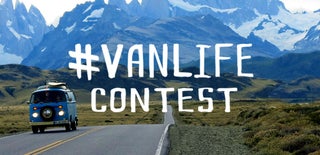Introduction: How to Find Campspots While Living That #VanLife
When you're new to Vanlife, it takes a while to get into the groove in regards to finding good camp spots on a daily basis. You might have the first small leg of your trip planned out, but eventually you will find yourselves trying to figure out where to camp that night, or the next day. Here are some tips and tools to help you through that learning curve.
Step 1: Know the Terminology...
A lot of people don't know what we're talking about when we mention dispersed, BLM, stealth camping etc... I thought I could help clear all of this up for anyone who might be looking to do an extended camp trip but hasn't yet figured it all out. Here is a quick breakdown of the different types of public land and methods of camping.
National Forest: When you look at most maps and see the green blotches here and there, that is typically indicating a national forest. National forests are patches of land that the government set aside for public use of all sorts. In general you can camp for free anywhere in a national forest, as long as it is not a "fee area" or if there is a sign specifically telling you not to camp in the spot you are interested in. Camping in a non designated area with no facilities is referred to as "dispersed camping". Most national forests will also have many designated Forest Service (FS) campgrounds with varying prices and amenities. We find that the average price for a FS campground is $15-20$. Some are even free! Most fee based FS campgrounds will have water, pit (or flush) toilets, and fire rings. They usually do not have showers or hookups (power and water at each campsite).
National Parks: These are sites that have been deemed important enough to be federally protected and curated to allow the public to access, but in such a way that their impact remains minimal. Most NPs will have at least one campground within it's borders. NPs are very popular amongst US citizens as well as foreign travelers, so they are usually very busy. This means that their campgrounds can be difficult to navigate, as the competition for sites can be very high during the summer season, and some remain this way even in the off seasons. I will do a separate blog post at some point with tips on how to get a good spot at NPs... I would say that NP campgrounds average about $20+/night. Sites at these campgrounds are often packed in a little closer together, and are set up for a high volume of visitors. Their rules are usually pretty a bit more strict as far as collecting wood, draining dish water, etc. They will often have centrally located bathrooms with a designated room/area for washing dishes or disposing of grey water. Sometimes they will have showers (usually coin operated) and sometimes they will even have camp stores and/or a laundromat. They will almost always have an area where RVs can fill up their fresh water tanks and dump their grey/black water tanks. NP campgrounds often times have a tent only loop and then more loops with sites big enough for small campers and large RVs alike. NP campgrounds will usually have mixture of reservable, and first come first serve sites. Most National Parks will have several RV parks (I'll talk about these as well) located just outside the park's borders attempting (and succeeding) to capitalize on people who couldn't find a spot in the official campground. Often times you can even find Dispersed Camping within a close enough proximity to the NP.
State Parks: State Parks will often have lots of amenities like showers and hookups for RVs, but they will usually come at a steeper rate. We don't stay at state parks very often because they usually cost at least $30-35/night. They are typically very nice places though with some sort of attraction, such as a lake, waterfall, hikes, etc. In my opinion, SPs are great for people who live nearby and want a nice place to camp for the weekend. For people like us who are camping every night for an an extended period of time, they just aren't sustainable. Most of them seem to be entirely reservable, which is also difficult for people who are going with the flow like us, because they almost always full durring the peak season.
BLM Land: Areas controlled by the Beurea of Land Management are considered public land as well. 1/8 of the landmass of the US is actually BLM land, but it is almost entirely contained in the western half of the states, and in Alaska. As far as camping goes, BLM land is pretty similar to NF, it can be used for dispersed camping, and will often times have designated/fee based campgrounds as well.
RV Parks: RV parks are virtually everywhere. It is hard to describe them because they are all privately owned, meaning they don't have much standardization. They serve a purpose and fulfill a need, but they aren't usually our cup of tea. They are primarily geared towards people with very large RVs (often full-timers) who would have difficulty finding a large enough campsite with all their hookup requirements anywhere else. We have only stayed at RV Parks when we have exhausted every other option. We do however find ourselves stopping at them during the day from time to time to do our laundry and take showers at the same time. Killing two birds with one stone is priceless sometimes...
Stealth Camping: Sometimes we just can't find a legit camping situation, or we just really want or need to stay within a town or city. If you are traveling in a relatively discrete camper like ours, you can get away with camping in low profile neighborhoods, or other places that don't have strict parking rules and minimal police patrol. If you do need to stealth camp in a neighborhood or any other "non-legit" spot, it is best to show up just before bed, and get up and out of there earlyish the next day. This will call less attention to you, and people are much less likely to get annoyed with your presence. It's nice to hang out at a city park during the day if you don't have anything else specific to do, then move to your sleeping spot nearby just before bedtime. The next morning you can head back to the park to make breakfast! If you want to camp in a city without fear of the dreaded midnight knock on the door, you can consider staying in the parking lot of a Walmart if there is one nearby. Walmarts often allow overnight parking for at least 24 hours with no judgment. This is no secret, we have stayed at them alongside 20-30 other RVs, no joke! There is the added benefit that many of them are 24 hour, meaning there is a nice clean bathroom nearby and you can always go buy all the cheap evil products you desire in the middle of the night! They are considered safe as well because the lots all under constant video surveillance. Not all walmarts allow overnight camping, but many do. When in doubt, ask the manager or refer to the Allstays app that I will list at the bottom of this article. Most of the time it is easy to tell that it is ok though, because there will likely already be several giant RVs parked along the outer edge of the parking lot.
*This is not a comprehensive list, but its a good start. A lot of my statements are generalized because the details of how each of these places can vary greatly from one to the next.
Step 2: Get the Apps...
Smartphone apps that we find extremely useful: The Ultimate Public Campgrounds App (AKA: Ultimate CG) - This is our favorite app because it not only lists most all of the designated campgrounds, but it also shows dispersed camping as well. We have found it to be pretty thorough, but it doesn't contain all dispersed camping locations. Some of the smaller more secret areas have to be discovered in other ways. For each location listed the app will show several details including the months of operation, amenities, and a $ scale from cheap to expensive. Allstays Camp&RV - This app is great for finding locations and details on private RV parks, dump stations, Walmarts, and other spots at would be useful to RV campers. This App is definitely geared more towards people with larger RVs, but can still be helpful to people with smaller campers or even tent campers. This App does show many of the larger NP and NF campgrounds, but it does not show some of the smaller ones nor does it show BLM or dispersed camping.
Step 3: Get Out There and Enjoy!
We found countless amazing camp spots during our 6+ months of vanlife. Sure there were some walmart stays and less than desirable locations sprinkled in here and there, but that is all part of the experience. If you use these tips and tools, you can keep those nights to a minimum, and live an amazing #VanLife!

Runner Up in the
#Vanlife Contest

Participated in the
Travel Contest 2017













